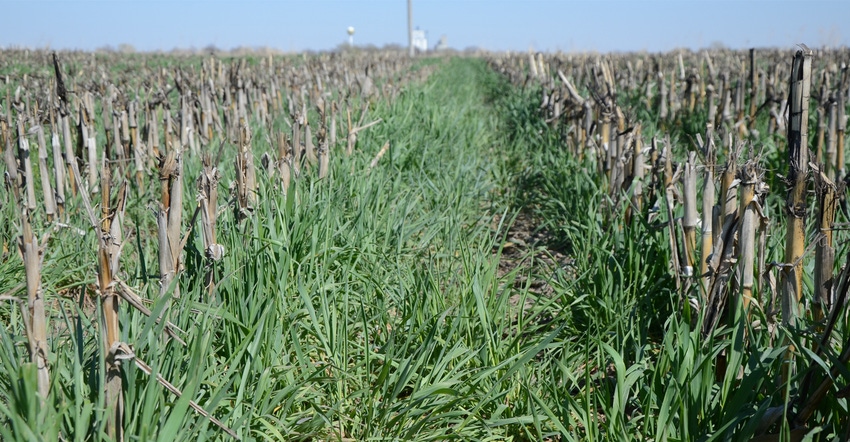
When it comes to gauging soil health, we often talk about the chemical and biological measurements first. But Aaron Hird, Nebraska Natural Resources Conservation Service soil health specialist, notes that the physical component often gets less attention.
Hird defines soil health as the continued capacity of the soil to function — in other words, the ability to continue to hold water, cycle nutrients, host soil biology and remain resilient in the wake of weather extremes such as heavy rainfall or dry periods.
"We've seen a lot of extreme weather in the last year," Hird says. "Maybe it's actually an extreme reaction to the precipitation we're getting. Our infiltration rates have decreased to a point where we can't get water in the ground fast enough, even to cope with small amounts of rain."
As part of Nebraska NRCS' Soil Health Initiative, which kicked off in 2016, farms in 17 Nebraska counties are serving as soil health demonstration sites. This gives growers, NRCS and their partners in the project — the University of Nebraska-Lincoln, Nebraska Extension and the Nebraska On-Farm Research Network — a chance to observe and measure soil health indicators and their improvement over time through cover cropping and practices used to build soil health.
Showing the results of these practices such as cover crops through demonstration plots helps communicate clear advantages.
Over the past year, Hird says when low infiltration rates were measured on demonstration farms, they were strongly correlated with high-bulk densities at varying soil depths. And when it comes to rebuilding the soil's physical characteristics, one of the first areas to focus on is the plow pan layer, he says.
"Even if we get water to go 4 inches down, it stops at the first restriction layer," Hird says. "I have root data that shows the top plow pan layer with a bulk density of 1.9 grams per cubic centimeter. It should be between 1.33 and 1.43. At 1.33, it's half soil and half air, because a solid piece of soil is 2.66 grams per cubic centimeter. Ideally, we can get below 1 gram per cubic centimeter."
Cash crop roots can move just fine through a bulk density of 1.33 to 1.43 grams per cubic centimeter.
"But right at the first compaction layer, it reaches 1.8 to 1.9," Hird says. "Through the research data I've found, that has shown that all of our agronomic cash crop roots are prevented from going forward through that bulk density. When roots can't get through that layer, there are no channels, there's no air movement, and so there's no mass water flow. It's more of a wicking, and that takes a lot of time. By then, the water's gone. It's on the soil surface and moving down the hillside."
Measurements also are taken after one year of cover crops.
"Some of our cover crop species have a lot higher rooting pressure tolerance than cash crops," Hird says. "They can exert themselves against higher density and force their way through the compaction layer, thereby creating a passageway. And then the next season, we can break through that layer with cash crop roots — that's a benefit of cover crops after only one year."
The Soil Health Assessment also involves digging a hole to visually see the compaction layer firsthand — and shows the benefit of planting cover crops to address the compaction problem.
"We need to address that compaction layer before we move into additional healthy soil discussions where we diversify the system, and attracting diverse microbiology," Hird says. "We have this slab of concrete at 4 inches deep, and we need to get that solved, and solved naturally, because we can't solve a problem created by iron with more iron."
The deeper the tillage, the deeper the compaction layer. And the deeper the compaction layer, the less biologically activity. It's much easier for roots to reach and penetrate a compaction layer that's 4 inches deep than one that's 16 inches deep.
Of course, there's a difference between compaction from equipment traffic and tillage-induced compaction layers. Compaction from traffic can't be completely avoided, but infiltration can be improved on the rest of the field.
"Farming itself is a disturbance," Hird says. "We can't get away from tire traffic. We're not going to harvest crops with an airplane. We need to depend more on a controlled traffic system."
This may involve taking steps to limit the number of passes in the field, and running implements in the same track. When it comes to managing grain cart compaction, it may mean asking part-time employees to follow those same travel lanes.
"Tire compaction leaves compaction layers down 4, 5, 6 inches deep until it dissipates, and it's a C-shape," Hird says. "Tillage-induced compaction is much more like a sheet of paper that lies across an entire field. When I grew up tilling, I always thought about tillage moving forward; I didn't think about the force of the blade downward in the ground. It's about 250 PSI per blade going down as you're moving forward through the field. We have to start thinking about the down pressure this equipment is exerting."
About the Author(s)
You May Also Like






